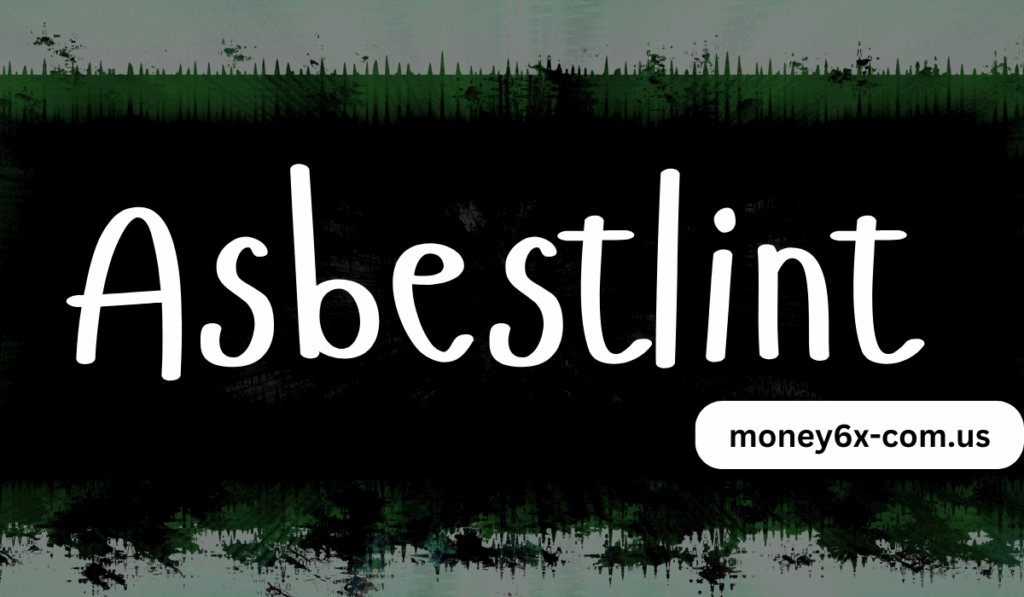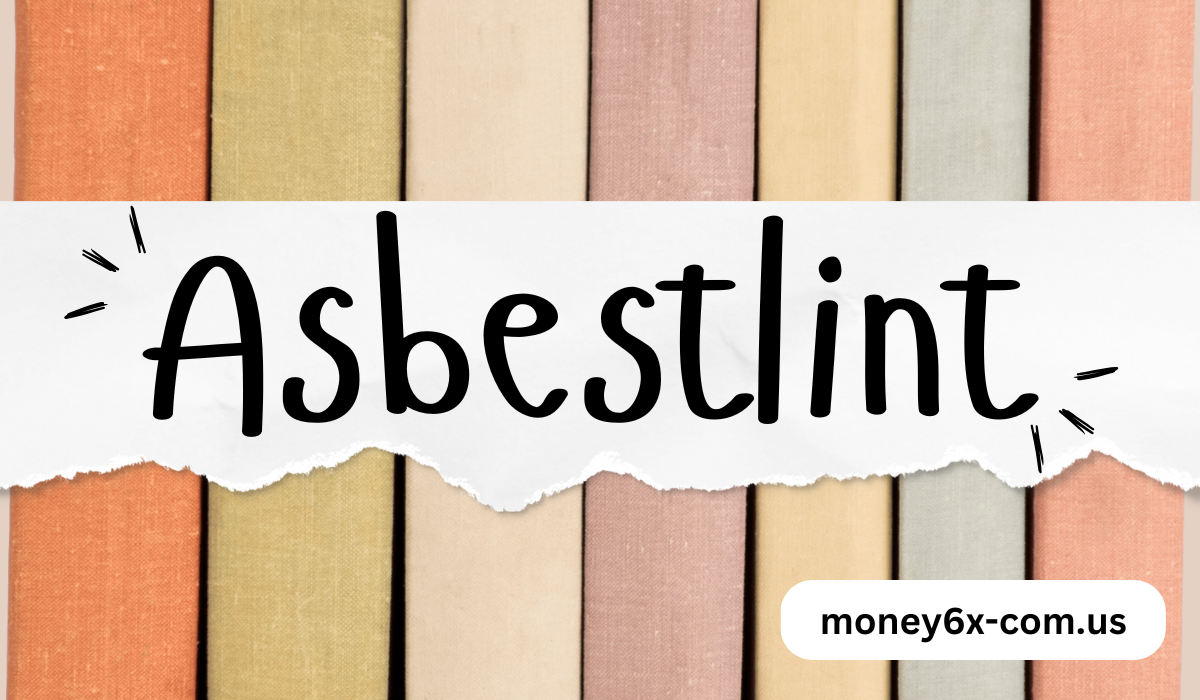Everything You Need to Know About Asbestlint: A Comprehensive Guide
Asbestos was once considered a miracle material, praised for its heat resistance, insulation properties, and versatility. However, due to its hazardous effects on human health, its use has been heavily regulated and, in many cases, banned in numerous countries. Despite this, remnants of asbestos-containing materials still pose risks, especially during renovation, demolition, or maintenance projects.
One of the lesser-known but still important asbestos-related materials is asbestlint. In this guide, we will delve deep into understanding what asbestlint is, its properties, uses, risks, and how to handle it safely.
What is Asbestlint?
Asbestlint is a type of asbestos-based sealing tape or gasket used predominantly for insulation and sealing purposes in various industries, including construction, automotive, and manufacturing. The term asbestlint is derived from the Dutch word for “asbestos tape” or “asbestos lint.” This material is made by weaving or compressing asbestos fibers into a tape form, which is then used in applications where heat resistance, fire resistance, and insulation are required.
Historically, asbestlint has been used in a wide range of applications, such as sealing joints, doors, windows, and pipes. It was also frequently used in the automotive industry to create heat-resistant seals for engine components, exhaust systems, and brake linings.
The Composition of Asbestlint
Asbestlint is typically composed of chrysotile, amosite, or crocidolite asbestos fibers. These fibers are tightly woven into the fabric of the tape or gasket, creating a flexible yet durable material. Depending on the specific application, asbestlint can vary in thickness, length, and overall strength, allowing for customization based on the needs of the project or machinery.
While the physical characteristics of asbestlint make it an effective material for insulation and sealing, it is important to note that the presence of asbestos fibers can present serious health risks if disturbed. When damaged or cut, asbestos fibers can become airborne, leading to inhalation and potential long-term health consequences.
Uses of Asbestlint
Asbestlint was once considered a highly useful material due to its excellent thermal and fire-resistant properties. Here are some of the major uses of asbestlint:

1. Sealing and Insulation
Asbestlint was commonly used to seal joints in pipes, boilers, and ducts, especially in industries where high heat resistance was necessary. The material provided a durable and effective seal to prevent heat loss and maintain efficiency in industrial machinery.
2. Automotive Applications
In the automotive industry, asbestlint was widely used to create heat-resistant seals and gaskets in components such as engines, exhaust systems, and brake linings. Its ability to withstand high temperatures and provide a secure seal made it an essential part of vehicle manufacturing.
3. Construction and Building Industry
Asbestlint was also used in the construction industry, primarily as a sealing material around windows, doors, and other openings where heat resistance was critical. It was also employed to insulate pipes and ducts, especially in buildings that needed to comply with stringent fire safety regulations.
4. Industrial Equipment and Machinery
Asbestlint was often used in industrial machinery, such as pumps, valves, and compressors. The material’s resistance to heat and wear made it an ideal solution for ensuring the longevity and safety of these pieces of equipment.
Health Risks Associated with Asbestlint
The primary concern surrounding asbestlint is the health risks associated with exposure to asbestos fibers. When asbestlint is damaged, it can release tiny, microscopic asbestos fibers into the air. These fibers, when inhaled, can lead to serious health conditions, including:
1. Asbestosis
Asbestosis is a chronic lung disease caused by prolonged exposure to asbestos. Inhalation of asbestos fibers can lead to scarring of the lung tissue, causing difficulty breathing, coughing, and chest pain.
2. Mesothelioma
Mesothelioma is a rare and aggressive form of cancer that affects the lining of the lungs, heart, or abdomen. It is most commonly associated with asbestos exposure and can develop many years after initial exposure.
3. Lung Cancer
Asbestos exposure is a known cause of lung cancer. The risk of developing lung cancer is significantly increased in individuals who smoke and have been exposed to asbestos fibers.
4. Other Respiratory Issues
In addition to the more severe conditions, exposure to asbestos can lead to other respiratory issues such as coughing, wheezing, and shortness of breath. These symptoms often go unnoticed for many years but can eventually result in serious health problems.
Mitigating Risks
Because of these significant health risks, the handling of asbestlint requires extreme caution. If you encounter asbestlint during a renovation or demolition project, it is crucial to follow strict safety protocols to avoid exposure. This includes wearing protective equipment such as respirators, gloves, and protective clothing, as well as ensuring that the material is properly contained and disposed of by certified professionals.
Proper Handling and Disposal of Asbestlint
If you find asbestlint in your home, business, or construction site, it is essential to handle it with care. Here are some guidelines for safely dealing with asbestlint:
1. Do Not Disturb the Material
If you discover asbestlint that is intact and undamaged, do not disturb it. As long as the material is in good condition, the asbestos fibers are unlikely to pose a significant risk. However, cutting, sanding, or damaging the asbestlint can cause fibers to become airborne, posing a serious health hazard.
2. Wear Protective Equipment
If you need to handle or work around asbestlint, make sure to wear appropriate protective gear. This includes a high-quality respirator with a P100 filter, protective clothing that covers the entire body, gloves, and safety glasses.
3. Hire a Professional Asbestos Removal Service
If the asbestlint is damaged or if you are unsure about how to handle the material, it is crucial to hire a professional asbestos removal service. Certified asbestos removal experts are trained to safely remove and dispose of asbestos materials in accordance with local regulations.
4. Safe Disposal of Asbestlint
Asbestlint should never be disposed of in regular trash or sent to a landfill without special handling. There are specific regulations governing the disposal of asbestos-containing materials, and improper disposal can lead to significant environmental and legal consequences. Always work with certified asbestos removal professionals who can ensure the safe and compliant disposal of the material.
Regulations and Legal Considerations
Asbestos use has been heavily regulated in many countries due to the serious health risks it poses. If you are dealing with asbestlint, it is crucial to understand the relevant regulations and legal requirements surrounding its removal and disposal in your area.

1. Asbestos Regulations in the EU
In the European Union, the use of asbestos has been banned since 2005, and strict regulations govern the removal and disposal of asbestos-containing materials. Asbestlint, along with other asbestos-containing products, must be removed by licensed professionals who follow proper safety protocols.
2. Asbestos Regulations in the US
In the United States, asbestos use is still regulated, with the Environmental Protection Agency (EPA) setting strict guidelines for the handling and disposal of asbestos-containing materials. The Occupational Safety and Health Administration (OSHA) also enforces rules that protect workers from asbestos exposure in construction and demolition settings.
Alternatives to Asbestlint
Due to the health hazards associated with asbestos, many industries have turned to safer alternatives to replace asbestlint. These alternatives include materials such as:
1. Fiberglass Tape
Fiberglass tape is an excellent alternative to asbestlint for insulation and sealing purposes. It offers high-temperature resistance and durability without the health risks associated with asbestos.
2. Silicone Gaskets
Silicone gaskets and seals are widely used in the automotive and construction industries due to their heat resistance, flexibility, and non-toxic properties.
3. Ceramic Fiber Insulation
Ceramic fiber insulation is another alternative that offers high-temperature resistance. It is commonly used in industrial applications and provides excellent insulation without the risk of asbestos exposure.
Conclusion
Asbestlint, while once a crucial material for various industries, is now recognized for its potential health risks. The inhalation of asbestos fibers can lead to serious diseases, including asbestosis, lung cancer, and mesothelioma. For this reason, it is crucial to understand the risks, proper handling procedures, and disposal regulations associated with asbestlint.
If you encounter asbestlint during your work or renovation projects, ensure that you follow safety guidelines and seek professional help when necessary. While alternatives to asbestlint are now available, its historical significance remains a reminder of the importance of safe material handling and the long-term effects of asbestos exposure. By staying informed and cautious, you can minimize the risks associated with asbestlint and protect both your health and the environment.







